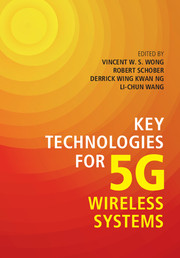Book contents
- Frontmatter
- Contents
- List of Contributors
- Preface
- 1 Overview of New Technologies for 5G Systems
- Part I Communication Network Architectures for 5G Systems
- Part II Physical Layer Communication Techniques
- 6 Non-Orthogonal Multiple Access (NOMA) for 5G Systems
- 7 Flexible Physical Layer Design
- 8 Distributed Massive MIMO in Cellular Networks
- 9 Full-Duplex Protocol Design for 5G Networks
- 10 Millimeter Wave Communications for 5G Networks
- 11 Interference Mitigation Techniques for Wireless Networks
- 12 Physical Layer Caching with Limited Backhaul in 5G Systems
- 13 Cost-Aware Cellular Networks Powered by Smart Grids and Energy Harvesting
- 14 Visible Light Communication in 5G
- Part III Network Protocols, Algorithms, and Design
- Index
- References
11 - Interference Mitigation Techniques for Wireless Networks
from Part II - Physical Layer Communication Techniques
Published online by Cambridge University Press: 28 April 2017
- Frontmatter
- Contents
- List of Contributors
- Preface
- 1 Overview of New Technologies for 5G Systems
- Part I Communication Network Architectures for 5G Systems
- Part II Physical Layer Communication Techniques
- 6 Non-Orthogonal Multiple Access (NOMA) for 5G Systems
- 7 Flexible Physical Layer Design
- 8 Distributed Massive MIMO in Cellular Networks
- 9 Full-Duplex Protocol Design for 5G Networks
- 10 Millimeter Wave Communications for 5G Networks
- 11 Interference Mitigation Techniques for Wireless Networks
- 12 Physical Layer Caching with Limited Backhaul in 5G Systems
- 13 Cost-Aware Cellular Networks Powered by Smart Grids and Energy Harvesting
- 14 Visible Light Communication in 5G
- Part III Network Protocols, Algorithms, and Design
- Index
- References
Summary
Introduction
Mobile broadband communications based on fourth generation (4G) Long Term Evolution (LTE) services are currently being deployed worldwide and are increasingly expanding across global markets, providing a user experience that was previously possible only through wired connections. The evolving fifth generation (5G) of wireless communication systems is expected to cope with a thousand-fold increase in total mobile broadband data and a hundred-fold increase in connected devices. It will also be required to overcome various challenges affecting current cellular networks, and provide higher data rates, improved end-to-end performance and coverage, low latency, and low energy consumption at low cost per transmission [1]. These challenges are expected to be addressed in 5G wireless networks by adopting a multi-tier heterogeneous architecture, since the capacity of the current macrocellular network cannot be increased infinitely. Future mobile networks will comprise macrocells and small cells, relays, and device-to-device (D2D) links, while they will be accessed by a large number of smart and heterogeneous devices.
This chapter discusses the management of interference in wireless networks of the 5G era. In the following, the goals of 5G networks and the interference management challenges they pose are first presented. Furthermore, the characteristics of future mobile networks which offer new tools for combating interference are also summarized. In this framework, coordinated multipoint techniques for both the uplink and the downlink are revisited, with special focus on the improvement of the cell-edge user experience. Finally, two indicative techniques for interference management are discussed, namely interference alignment and the compute-and-forward protocol.
The Interference Management Challenge in the 5G Vision
The 5G Primary Goals and Their Impact on Interference
The advance from 4G to 5G networks is based on some primary visions and goals, which are summarized in the following [2]:
• High data rates and low latency. 5G networks are envisioned to enable data rates of 300 Mb/s and 60 Mb/s in the downlink and uplink, respectively, and end-to-end latency between 2 and 5 milliseconds.
• Machine-type communications (MTC). The Internet of Things (IoT) is expected to introduce a large number of self-organized MTC devices, such as home appliances, and surveillance and sensor devices.
Information
- Type
- Chapter
- Information
- Key Technologies for 5G Wireless Systems , pp. 214 - 235Publisher: Cambridge University PressPrint publication year: 2017
References
Accessibility standard: Unknown
Why this information is here
This section outlines the accessibility features of this content - including support for screen readers, full keyboard navigation and high-contrast display options. This may not be relevant for you.Accessibility Information
- 1
- Cited by
